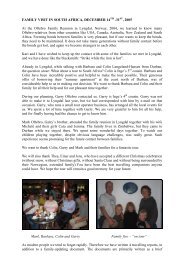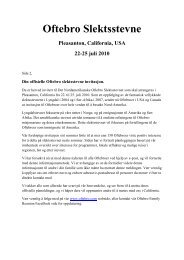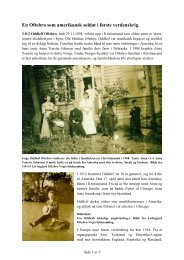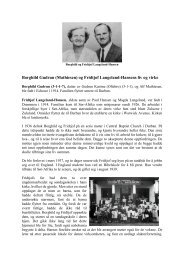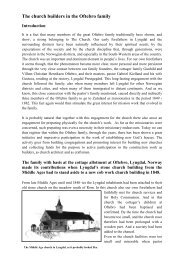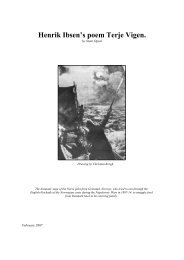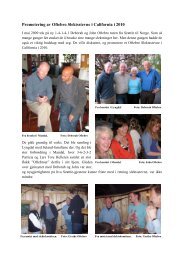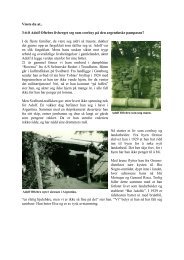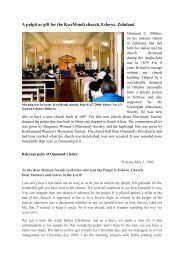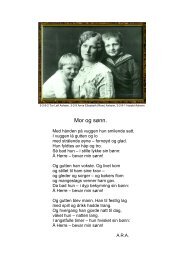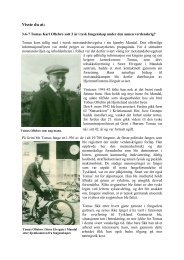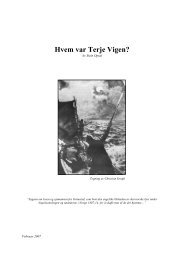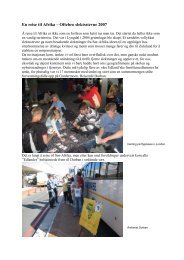Anna Elisabeth Oftebro and Jens Christensen Opsal
Anna Elisabeth Oftebro and Jens Christensen Opsal
Anna Elisabeth Oftebro and Jens Christensen Opsal
Create successful ePaper yourself
Turn your PDF publications into a flip-book with our unique Google optimized e-Paper software.
3-5 <strong>Opsal</strong> <strong>Jens</strong> <strong>and</strong> <strong>Anna</strong> <strong>Elisabeth</strong><br />
<strong>Jens</strong> Chr. <strong>and</strong> <strong>Anna</strong> <strong>Elisabeth</strong> <strong>Opsal</strong><br />
The siblings <strong>Anna</strong>, Thora (Andvig), Karl <strong>and</strong> Torleiv <strong>Opsal</strong> were all born in<br />
the Norwegian town Grimstad in the period 1883 to 1893. They were raised in a<br />
family with strong family ties <strong>and</strong> mutual interests, <strong>and</strong> kept through the years<br />
close contact with each other. The four of them were all educated as teachers.<br />
They developed a strong interest in genealogy. <strong>Anna</strong> <strong>and</strong> Torleiv learned to read<br />
Gothic, <strong>and</strong> studied eagerly old documents.<br />
The siblings lived in different parts of the country, so they kept in contact<br />
through correspondence.<br />
Some of the letters are<br />
kept <strong>and</strong> shows that their<br />
parents, the fathers‟<br />
education, interest <strong>and</strong><br />
eventful life, impressed<br />
the siblings.<br />
<strong>Jens</strong> <strong>and</strong> <strong>Anna</strong><br />
<strong>Elisabeth</strong> lived a rich life,<br />
<strong>and</strong> did their utmost to<br />
give the four children the<br />
same opportunities.<br />
The sibling gathered<br />
much information of the<br />
family, especially<br />
information <strong>and</strong> a huge<br />
archive of photos from<br />
their parents‟ life.<br />
They discussed to<br />
publish a book of their<br />
father's life, but did not<br />
come that far. Much of<br />
the information is<br />
unfortunately lost, but<br />
the following story is<br />
mostly from information<br />
the siblings gathered in<br />
the 1950's <strong>and</strong> 60's.<br />
The letter from Karl to<br />
his brother Torleiv<br />
dated 3 rd November<br />
1962, is ending with the<br />
words: "So is it left to<br />
write the story of <strong>Jens</strong><br />
<strong>Christensen</strong> <strong>Opsal</strong>".<br />
Stein <strong>Opsal</strong> 2009 - 1 -
3-5 <strong>Opsal</strong> <strong>Jens</strong> <strong>and</strong> <strong>Anna</strong> <strong>Elisabeth</strong><br />
Three generations at Eastern Rom, Lyngdal in 1922.<br />
Behind from left: Karl, Thora, <strong>Anna</strong> <strong>Elisabeth</strong>, Ellen, Bertha, Torleiv, <strong>Jens</strong> <strong>and</strong> Jørgen<br />
In front from left: <strong>Jens</strong>, Gisle, Astri, Kari <strong>and</strong> Finn<br />
The years 1860–1920<br />
In this story we follow the family of <strong>Jens</strong> <strong>Opsal</strong> <strong>and</strong> <strong>Anna</strong> <strong>Elisabeth</strong> <strong>Oftebro</strong><br />
through the last half of 1800-century <strong>and</strong> until <strong>Jens</strong> died in 1926. This period was<br />
in many ways marked by tough conditions in Norway, but gradually the<br />
modernization of the country began. Norway had a break as a separate nation,<br />
as the country was in union with Sweden until 1905, <strong>and</strong> owing to this the times<br />
was very unstable until the union came to an end.<br />
After the Napoleonic War in 1807 to 1814, Norway went through one of the<br />
worst depressions the country has experienced. Bankruptcies <strong>and</strong> unemployment<br />
affected the entire Europe. After 1830, we see the first sign of a new rise. In the<br />
1850s a far stronger business community grew up, <strong>and</strong> in the 1870s there were<br />
an unusually strong growth period in the country. The industry grew strongly in<br />
the 1890s, <strong>and</strong> in 1899 Borregaard was the country's largest factory with over<br />
1,000 employees. The population of Norway grew from ca. 880,000 in 1801 to<br />
over 2.2 million in 1900.<br />
After the union with Sweden ended in 1905 the period was marked by strong<br />
economic growth. Cheap electricity <strong>and</strong> foreign capital investments forced<br />
growth. Under World War I in the years 1914-1918, Norway declared itself<br />
neutral, along with Denmark <strong>and</strong> Sweden. The war led to boom <strong>and</strong> inflation, <strong>and</strong><br />
growth continued pretty much continuously until 1930.<br />
The major world crisis, which ushered in "the harsh 30s", began with a<br />
collapse on the stock exchange in New York in October 1929. The decline came<br />
fully to Norway in autumn 1930, <strong>and</strong> shortly after unemployment set new<br />
records. Prices fell <strong>and</strong> production in industry was reduced by over 20%. The<br />
Stein <strong>Opsal</strong> 2009 - 2 -
3-5 <strong>Opsal</strong> <strong>Jens</strong> <strong>and</strong> <strong>Anna</strong> <strong>Elisabeth</strong><br />
price of agricultural products in 1933 was down to 1/3 of what they had been in<br />
the 1920s.<br />
The winters 1932-33 <strong>and</strong> 1933-34 about 40% of the trade unionists were<br />
unemployed. From 1934, the first sign of new growth showed, which continued<br />
until World War II came to the country with the German invasion 9 th April 1940.<br />
<strong>Jens</strong> C. <strong>Opsal</strong> in brief<br />
<strong>Jens</strong> was born on the farm <strong>Opsal</strong> in Lyngdal. Agriculture was his passion. He<br />
received his education at Huseby Acgricultural School at Lista, <strong>and</strong> at Ås Higher<br />
agricultural school in Akershus, where he was an agronomist. Later he taught<br />
as a teacher at agricultural schools in Førde <strong>and</strong> in Fana, before he started <strong>and</strong><br />
ran his own agricultural school at Imenes in Grimstad.<br />
He settled in Grimstad, founded family, <strong>and</strong> ran the state alcohol monopoly,<br />
merchant outlets <strong>and</strong> an own private dairy in the town. <strong>Jens</strong> was very socially<br />
engaged. He participated in starting agricultural schools, was engaged in<br />
discussions concerning the Norwegian language <strong>and</strong> educational st<strong>and</strong>ard in<br />
the society. He had a number of municipal offices <strong>and</strong> missions in his years in<br />
Grimstad.<br />
<strong>Jens</strong> <strong>and</strong> <strong>Anna</strong> <strong>Elisabeth</strong> returned to the farm Eastern Rom in Lyngdal in<br />
1914. <strong>Jens</strong> died there in 1926. <strong>Anna</strong> <strong>Elisabeth</strong> then moved to her children in<br />
Stavanger, where she lived with her son Karl to her death in 1940.<br />
Eastern Rom 1919<br />
<strong>Jens</strong> Chr. <strong>and</strong> <strong>Anna</strong> <strong>Elisabeth</strong> with the gr<strong>and</strong>children<br />
Finn Andvig (left) <strong>and</strong> <strong>Jens</strong> <strong>Opsal</strong><br />
Stein <strong>Opsal</strong> 2009 - 3 -
3-5 <strong>Opsal</strong> <strong>Jens</strong> <strong>and</strong> <strong>Anna</strong> <strong>Elisabeth</strong><br />
<strong>Jens</strong> <strong>and</strong> his siblings<br />
<strong>Jens</strong> <strong>Christensen</strong> <strong>Opsal</strong> was born on <strong>Opsal</strong> April 22 nd 1837, as the 4 th of the 6<br />
siblings. The first-born brother <strong>Jens</strong> died only 2 years old in 1834. The other 5<br />
were growing up.<br />
The <strong>Opsal</strong> siblings:<br />
1. <strong>Jens</strong> (1832-1834)<br />
2. Margrete Katrine (1834)<br />
3. John (1834)<br />
4. <strong>Jens</strong> (1837)<br />
5. Apelone (1840)<br />
6. Johanne Martine (1843)<br />
Margrete Katrine <strong>and</strong> John were twins <strong>and</strong> were born 15 th January 1834.<br />
Margrethe (1834-1913) was married to Kristen Resvik (1834-1894), from Resvik<br />
in Grimstad. There is great posterity after them in the Grimstad area.<br />
Margrethe <strong>and</strong> Kristen had 4 children. The oldest, Gunnar Kristensen (1856-<br />
1904) remained unmarried. Kristen Kristensen (1858-1943) went to USA, where<br />
he was married <strong>and</strong> later divorced. He had a daughter, Henriette Kristensen who<br />
was married in USA. Their brother Martinius Kristensen (1871 -) married Kirstine<br />
Bakken (1875-1958) <strong>and</strong> also went to the United States before they returned to<br />
Solborg in Grimstad. In USA Martinius was seaman <strong>and</strong> a clerk. The youngest<br />
brother, Anders Kristensen (1874-1919) was married to Johanne Beruldsen<br />
(1875-1916) <strong>and</strong> settled in Grimstad.<br />
John (<strong>Christensen</strong>) <strong>Opsal</strong> was <strong>Jens</strong>' only brother. The two brothers had much<br />
in common, <strong>and</strong> followed each other throughout life. Like <strong>Jens</strong> John settled in<br />
Grimstad, on the farm Imenes. John changed his name to Imenes after he<br />
married. His new name was thus John Imenes. Aase Andersdtr. Imenes was born<br />
at Imenes in 1840, <strong>and</strong> was only 17 years old when the two married in 1857.<br />
They took over half the farm at Imenes for 330 Spd. Inger, Aases mother, died<br />
in 1863. Three years later, in 1866, John <strong>and</strong> Aase took over also the last half,<br />
<strong>and</strong> the farm was again united.<br />
John died in 1904, <strong>and</strong> widow Aase then kept the farm to 1917, when her son<br />
Toralv Imenes took over. John <strong>and</strong> Aase had 3 sons, who all settled in Grimstad.<br />
The oldest son John Alex<strong>and</strong>er remained unmarried, lived at Imenes, <strong>and</strong><br />
became an insurance inspector. He was interested in politics <strong>and</strong> youth work,<br />
<strong>and</strong> was also involved in local history. He was chairman of L<strong>and</strong>vik local history<br />
organisation until his death in 1955.<br />
The brother Anders was shopkeeper in Grimstad, <strong>and</strong> has a large posterity in<br />
the area. The third brother, Karl, went out of town. A period he was a gold digger<br />
in Australia, <strong>and</strong> wrote, among other things, a book with scenes from the gold<br />
digging. Karl also wrote several other pieces <strong>and</strong> was both a poet <strong>and</strong> a<br />
newspaperman. Karls posterity is partly in Grimstad, <strong>and</strong> partly in USA.<br />
The background for the name Karl is unknown, but both <strong>Jens</strong> <strong>and</strong> John called<br />
one of their sons Karl.<br />
<strong>Jens</strong>' sister was married to Apelone Jacobi Kristensen from Kindingsl<strong>and</strong><br />
(1831-1918).<br />
Stein <strong>Opsal</strong> 2009 - 4 -
3-5 <strong>Opsal</strong> <strong>Jens</strong> <strong>and</strong> <strong>Anna</strong> <strong>Elisabeth</strong><br />
Grimstad 1910<br />
<strong>Anna</strong> (27), Thora (22), Karl (20) <strong>and</strong> Torleiv (17)<br />
<strong>Jens</strong>' youngest sister Johanne Martine (1843-1915) married Gunnar D. Timenes<br />
(d. 1928) from Timenes in R<strong>and</strong>esund outside Kristians<strong>and</strong>. They had 8 children,<br />
but 5 of them remained unmarried, <strong>and</strong> a sister died as children. Thus, only 2 of<br />
the 8 children grew up <strong>and</strong> have descendants.<br />
However these two children, Andreas Timenes <strong>and</strong> his sister Maria, who was<br />
married to Hans Emil Benestad, got large posterity. They had 6 children each, a<br />
total of 9 sons <strong>and</strong> 3 daughters. After Timenes <strong>and</strong> Benestad it is great number<br />
of descendants in Kristians<strong>and</strong> region.<br />
<strong>Anna</strong> <strong>Elisabeth</strong> <strong>and</strong> her siblings<br />
Anne <strong>Elisabeth</strong> was born October 31 st 1851 on the <strong>Oftebro</strong> farm. It was quite<br />
remarkable at that time that both she <strong>and</strong> her 8 siblings all grew up. All were<br />
married. The siblings were born in the years 1842 to 1861.<br />
Their descendants is currently spread over 3 continents. The elder brother<br />
Christian went to Eshowe mission in Zulul<strong>and</strong> in South Africa as a Medical<br />
Missionary. His uncle Ommund <strong>Oftebro</strong> was there at first as a missionary. He was<br />
educated at a missionary at the mission school's first class in Stavanger.<br />
Ommund travelled to Zulul<strong>and</strong> in 1848, <strong>and</strong> was one of the great pioneers of<br />
Norwegian missionary operation in South Africa.<br />
Hanna, Ommunds daughter <strong>and</strong> Christian‟s cousin, became Christians wife.<br />
They married January 8 th 1881. The couple settled in Zulul<strong>and</strong> <strong>and</strong> have a large<br />
posterity.<br />
Stein <strong>Opsal</strong> 2009 - 5 -
3-5 <strong>Opsal</strong> <strong>Jens</strong> <strong>and</strong> <strong>Anna</strong> <strong>Elisabeth</strong><br />
The <strong>Oftebro</strong> siblings:<br />
Lived in:<br />
1. Christian (1842) Zulul<strong>and</strong>, South Africa<br />
2. Gunhild Regine (1844)<br />
3. Karen Sofie (1846)<br />
4. <strong>Anna</strong> Tonette (1849) USA<br />
5. <strong>Anna</strong> <strong>Elisabeth</strong> (1851)<br />
6. Tobias (1853)<br />
7. Bertha Marie (1855) Zulul<strong>and</strong>, South Africa<br />
8. Ole Mathias (1858)<br />
9. Katrine Tobine (1861) USA<br />
Seven of the <strong>Oftebro</strong> siblings ca. 1865.<br />
From left: Bertha Marie, <strong>Anna</strong> <strong>Elisabeth</strong>, Tobias (behind), <strong>Anna</strong> Tonette,<br />
Ole Mathias, Karen Sofie <strong>and</strong> Katrine Tobine.<br />
The sisters <strong>Anna</strong> Tonette <strong>and</strong> Katrine Tobine married respectively Anders<br />
Johnsen <strong>and</strong> Rudolf Reime. In the 1880s, there was a considerable emigration to<br />
the United States, especially from the Agder counties. The two families searched<br />
a future in the new country. They were a group of 10 people leaving Lyngdal<br />
March 24 th 1883. The families settled down as farmers in the state of Nebraska.<br />
There is great posterity after them over most of USA.<br />
The other siblings were all married <strong>and</strong> settled in Norway. Gunhild Regine<br />
married June 4 th 1868 with Tollak Rom. He was a farmer at Rom <strong>and</strong> bank<br />
cashier in Lyngdal. They had 11 children, of whom 10 grew up <strong>and</strong> were married.<br />
Three of the children travelled to the United States <strong>and</strong> have a large posterity.<br />
The rest are scattered all over Norway.<br />
Karen Sofie married Nils Foss, who was farmer at Foss in Lyngdal. They had<br />
10 children, 7 of them grew up <strong>and</strong> were married. Six of these siblings travelled<br />
to the United States with their families, <strong>and</strong> have a large posterity.<br />
Stein <strong>Opsal</strong> 2009 - 6 -
3-5 <strong>Opsal</strong> <strong>Jens</strong> <strong>and</strong> <strong>Anna</strong> <strong>Elisabeth</strong><br />
The brother Tobias married November 3 rd 1887 to Kamilla S<strong>and</strong>ersen. They had 9<br />
children in the years 1888 to 1905. Six of them grew up <strong>and</strong> were married.<br />
Unlike their cousins they all stayed in Norway, with the exception of Adolf, who<br />
became a farmer in South America.<br />
Bertha Marie married April 9 th 1891 with Gustav Hojem. They travelled to<br />
Durban in South Africa.<br />
The last of the brothers, Ole Mathias, married July 4 th 1891 with Amalie Log.<br />
He was a teacher, <strong>and</strong> became school principal in Kristians<strong>and</strong>. Of their 4<br />
children, 3 married, <strong>and</strong> all lived in Norway. The oldest daughter Torbjørg (1892)<br />
was married to Kristian Grimsø. He was a vicar in Tinn in the county of Telemark<br />
<strong>and</strong> in S<strong>and</strong>efjord. The son Arnulf (1900) was a dentist in Tune in Østfold, while<br />
Aslaug (1908) was married to Arthur Evensen. He was a high school teacher in<br />
Oslo.<br />
Zulul<strong>and</strong> in South Africa<br />
<strong>Jens</strong> <strong>and</strong> <strong>Anna</strong> <strong>Elisabeth</strong>s parents<br />
<strong>Jens</strong> <strong>and</strong> <strong>Anna</strong> <strong>Elisabeth</strong> were third cousins. <strong>Jens</strong>' great-gr<strong>and</strong>father Christian<br />
Vraalsen Herdal was brother of <strong>Anna</strong> Elizabeth's great-gr<strong>and</strong>father Henry<br />
Vraalsen Herdal.<br />
John was son of Christen <strong>Jens</strong>en <strong>Opsal</strong>, born 20 th June 1801, <strong>and</strong> Anne<br />
Helene Jonsdtr. Lene, born 19th September 1804. They were married 9 th June<br />
1831. Christen was farmer at <strong>Opsal</strong> in Lyngdal. Anne Helene was daughter of Jon<br />
Pedersen Lene, born 5 th October 1779, <strong>and</strong> Apelone Aanensdtr. Bringsjord, born<br />
17 th October 1781.<br />
<strong>Anna</strong> <strong>Elisabeth</strong> was daughter of Tobias <strong>Oftebro</strong>, born at <strong>Oftebro</strong> 28 th<br />
December 1803, <strong>and</strong> Anne Kathrine Birkel<strong>and</strong>, born 17 th May 1821. Tobias<br />
married 38 years old with Anne Katrine who was 20 years old. They settled as<br />
tenants on the Outer Berge farm where they lived 19 years. Here they had their<br />
8 first children. While he was the leaseholder on the Outer Berge, Tobias around<br />
1845, demolished the old stone church, <strong>and</strong> built the foundation of the new<br />
Stein <strong>Opsal</strong> 2009 - 7 -
3-5 <strong>Opsal</strong> <strong>Jens</strong> <strong>and</strong> <strong>Anna</strong> <strong>Elisabeth</strong><br />
Lyngdal Church of the stones from the old. From 1860 the family was tenants at<br />
Lyngdal rectory, where their last child was born.<br />
In 1865 Tobias took over the farm Western Fidje from Anne Katrine's father,<br />
Torkild Ånensen (Birkel<strong>and</strong>) Fidje. The family had strong mission interests, <strong>and</strong><br />
Anne Katrine was active in the local missionary women's movement. Anne<br />
Kathrine was of "Good Family", as her family was descending from several of the<br />
old noble families in Norway, <strong>and</strong> also the Norwegian kings in the Middle Ages.<br />
The higher nobility around the Hardanger fjord is central among the ancestors.<br />
Eastern Rom 1919:<br />
In front: <strong>Anna</strong> - Ellen/Torleiv - Bertha/Karl - Thora/Jørgen - <strong>Anna</strong> <strong>Elisabeth</strong>/<strong>Jens</strong><br />
Children: <strong>Jens</strong> <strong>Opsal</strong> on <strong>Anna</strong>'s knee <strong>and</strong> Finn Andvig with Torleiv<br />
<strong>Jens</strong>' education in agriculture<br />
<strong>Jens</strong> developed in his youth a strong interest in farming <strong>and</strong> agriculture. He<br />
decided early to take education in that direction, <strong>and</strong> as he was "smart", he<br />
finished the highest education of the time. His brother John first went to Huseby<br />
Agricultural School in Vanse. <strong>Jens</strong> joined him in 1857, 20 years old, which was<br />
the start of an education that culminated with 2 years at Ås Higher Agricultural<br />
University as "free student".<br />
Lista & M<strong>and</strong>als County had the first agricultural school in 1847, located at<br />
the Berge farm in Lyngdal. After a few years the school developed so it had to<br />
look for a more suitable place. The Huseby farm in Vanse, proved to be suitable<br />
for this purpose.<br />
Stein <strong>Opsal</strong> 2009 - 8 -
3-5 <strong>Opsal</strong> <strong>Jens</strong> <strong>and</strong> <strong>Anna</strong> <strong>Elisabeth</strong><br />
The owner of Huseby, Peter Nicolai Otto, was educated in agriculture, <strong>and</strong><br />
developed the farm with great enthusiasm. He established tenant farmers <strong>and</strong><br />
exp<strong>and</strong>ed the farm by cultivation. From 1855 the farm was rented to the<br />
agricultural school. The contract was written September 2 nd 1855 between Otto<br />
<strong>and</strong> the school. Otto rented out Huseby for 10 years against an annual payment<br />
from the county of 800 Spd. Otto would then pay a theory teacher 320 Spd. in<br />
annual salary, as well as lodging <strong>and</strong> firewood. He also had to pay salary to a<br />
practical teacher, which the theory teachers could accept. Eight students were to<br />
stay for free at the school, while further 4 pupils could be taken up after<br />
acceptance of Otto. The theoretical teacher should also be the manager. The<br />
school started with the first students 14 th April 1856.<br />
<strong>Jens</strong>' older brother John, first went to Huseby, <strong>and</strong> was a student at the<br />
school's first class in 1856. The following year, in 1857, <strong>Jens</strong> followed as a<br />
student at the school. After <strong>Jens</strong> graduated in 1858, he was offered a position as<br />
a farm manager <strong>and</strong> practical teacher at the school. He was 21 years old, <strong>and</strong><br />
was on the farm for a year.<br />
The agricultural School was at Huseby until 1868, but was then closed. The<br />
owner Otto didn‟t stay long at the farm, as his wife didn‟t feel comfortable on the<br />
exposed farm. A very strong storm went over Lista in February 1869, <strong>and</strong> let the<br />
big building at Huseby in ruins.<br />
In order to continue his plans for education in agriculture <strong>Jens</strong> wanted to get<br />
out of the military service. His son Karl told the story of his father's military<br />
career in a letter to his brother Torleiv in 1962:<br />
"That our father got free from his military service - as at that time was<br />
extremely hard – was thanks to his father. Gr<strong>and</strong>father (Christen <strong>Jens</strong>en <strong>Opsal</strong>)<br />
went on foot to Kristians<strong>and</strong> (or Arendal?) to get him out. The “price” for this is<br />
unknown, but it had to be partly compensated by being postman for a while. I<br />
think I’ve heard something about 2 years."<br />
From Lista through Ås to Førde <strong>and</strong> Fana<br />
After ending his stay at Huseby Agricultural School, <strong>and</strong> then got himself free<br />
from the military, <strong>Jens</strong> moved to "The higher Agricultural School at Ås" (today Ås<br />
Agricultural University) where he was granted free studies for 2 years. The<br />
school was opened in 1859, <strong>and</strong> was at the time the highest education in<br />
agriculture in Norway. <strong>Jens</strong> studied at Ås in the years 1860 - 1862.<br />
<strong>Jens</strong> finished the studies at Ås as the best student. It is said that the<br />
students, by the awarding of the school certificates, was set up in order of<br />
performance. As <strong>Jens</strong> had the best grades he should be placed first, but he was<br />
put in third place after two students from more affluent families. <strong>Jens</strong> was so<br />
annoyed of this injustice that he tore apart the certificate.<br />
His son Torleiv wrote many years later, in a letter to his brother Karl, that<br />
"there was much of an achievement - under the circumstances he grew up - to<br />
receive such an education at that time."<br />
After finishing his studies on Ås in 1862 <strong>Jens</strong> was agronomist. He was 25<br />
years old, but had already graduated, <strong>and</strong> had also received practice as a<br />
teacher <strong>and</strong> a farm manager at Huseby agricultural school. He wanted new<br />
challenges <strong>and</strong> was the same year employed as a teacher at an agricultural<br />
school in Mo i Førde, Sunnfjord, where he stayed for 4 years, until 1866.<br />
Stein <strong>Opsal</strong> 2009 - 9 -
3-5 <strong>Opsal</strong> <strong>Jens</strong> <strong>and</strong> <strong>Anna</strong> <strong>Elisabeth</strong><br />
Stend Agricultural School in Fana 1869, where <strong>Jens</strong> was teacher from 1866.<br />
At the same time a new agricultural school was established in Bergen. The<br />
county bought the property in 1861 at Stend in Fana to start an agricultural<br />
school for the county. The farm was over 2000 acres, of which approximately<br />
1,200 acres of productive forest. The farm is the largest agricultural farm in the<br />
county.<br />
The first class at Stend agricultural school began October 1 st 1866. <strong>Jens</strong> left<br />
his job as a teacher in Førde, <strong>and</strong> was part of establishing the new school in<br />
Fana. His daughter Thora later said that <strong>Jens</strong> went on foot over the mountains to<br />
Stend. He loved hiking in the mountains, <strong>and</strong> made a huge collection of stones<br />
on his trips.<br />
Grimstad<br />
In the county-book of L<strong>and</strong>vik, under Imenes, we find a little notice about <strong>Jens</strong>.<br />
It says;<br />
"The first agricultural college in the county was started at Imenes in the<br />
1870s. <strong>Jens</strong> <strong>Opsal</strong> ran the school. The school was active only a short<br />
period. <strong>Jens</strong> <strong>Opsal</strong> was later alcohol monopoly manager in Grimstad.<br />
Agricultural schools were the first sign of a new era. It became a shift in<br />
the hundred-year-old production practices. In these years a dairy was<br />
established in Grimstad, <strong>and</strong> farmers started sending milk there."<br />
It was <strong>Jens</strong>‟ big brother John who made <strong>Jens</strong> move to Grimstad. John had the<br />
same strong interest in farming as his brother, <strong>and</strong> moved to Grimstad already in<br />
1857, the year after he completed the Agricultural school at Huseby. He married<br />
that same year with Åse Andersdtr. Imenes. They bought half the farm on<br />
Imenes for 330 Spd., <strong>and</strong> thus John became a farmer only 23-year-old. There<br />
Stein <strong>Opsal</strong> 2009 - 10 -
3-5 <strong>Opsal</strong> <strong>Jens</strong> <strong>and</strong> <strong>Anna</strong> <strong>Elisabeth</strong><br />
are currently a large number of descendants after John <strong>Christensen</strong> Imenes in<br />
the Grimstad region.<br />
After having traveled a lot of places in the country, both for education <strong>and</strong><br />
later as a teacher in Førde <strong>and</strong> Fana, <strong>Jens</strong> went to Grimstad in the early 1870s.<br />
He then came close to John, who was established with his family <strong>and</strong> ran the<br />
farm at Imenes.<br />
<strong>Anna</strong> <strong>Elisabeth</strong> <strong>and</strong> Karl in 1892<br />
<strong>Jens</strong> decided to settle in the Grimstad area, near his brother's family, <strong>and</strong> soon<br />
he started planning his own agricultural school in the area. As John owned <strong>and</strong><br />
ran the farm at Imenes, it was natural for <strong>Jens</strong> to establish his agricultural school<br />
at the farm.<br />
The initiative for operating the agricultural school in Grimstad is typical for<br />
<strong>Jens</strong>. All his life he was passionately interested in the operation <strong>and</strong> development<br />
of all aspects of agriculture <strong>and</strong> farming, which he demonstrated by agronomist<br />
education at Ås, his own farm, <strong>and</strong> teaching on various agricultural schools. He<br />
was also a pioneer in the dairy operation until he was 75-76 years.<br />
<strong>Anna</strong> <strong>Elisabeth</strong> was also born in Lyngdal, <strong>and</strong> was <strong>Jens</strong>‟ third-cousin. She<br />
worked several years as a housekeeper for <strong>Jens</strong>, but became somewhat<br />
dissatisfied with the conditions. She finally wanted to quit the job, partly because<br />
of the desire for higher wages. <strong>Jens</strong> responded to propose to <strong>Anna</strong> <strong>Elisabeth</strong>.<br />
Stein <strong>Opsal</strong> 2009 - 11 -
3-5 <strong>Opsal</strong> <strong>Jens</strong> <strong>and</strong> <strong>Anna</strong> <strong>Elisabeth</strong><br />
The two were married June 19 th 1882. All their children were born in Grimstad in<br />
the years 1883 to 1893.<br />
The <strong>Opsal</strong>-siblings were:<br />
1. <strong>Anna</strong> (1883)<br />
2. Katrina (1885-1889)<br />
3. Tobine (1886-1886)<br />
4. Thora (1888)<br />
5. Karl (1890)<br />
6. Katrina (2) (1892-1895)<br />
7. Torleiv (1893)<br />
<strong>Jens</strong> became a "business man", as manager of the alcohol monopoly <strong>and</strong> later<br />
Dairy Manager in Grimstad, positions he held for many years, until the family<br />
returned to the farm at Eastern Room in Lyngdal.<br />
Grimstad 1905<br />
<strong>Anna</strong> (22), Thora (17), Karl (15) <strong>and</strong> Torleiv (12)<br />
The Alcohol Monopoly in Grimstad<br />
In 1816, the Parliament gave owners <strong>and</strong> users of free l<strong>and</strong> access to make<br />
liquor to private use, while the urban population was allowed to make their own<br />
liquor if the boiler was at least 200 liters. The result was massive consumption<br />
<strong>and</strong> large social consequences. The brakes had to be put on.<br />
In addition to reductions in alcohol trade <strong>and</strong> also new taxes, the Alcoholic<br />
Monopoly was established in 1871.<br />
Stein <strong>Opsal</strong> 2009 - 12 -
3-5 <strong>Opsal</strong> <strong>Jens</strong> <strong>and</strong> <strong>Anna</strong> <strong>Elisabeth</strong><br />
License to sell liquor should be given to the Monopoly, <strong>and</strong> the profit should go to<br />
the public activities. The municipalities would decide whether licenses should be<br />
granted.<br />
"The Green House" was placed on the corner of Bryggegata <strong>and</strong><br />
Skolegata in Grimstad. The building was erected around 1880 <strong>and</strong> was for a long time<br />
used for liquor sales. The house was demolished in the 1950s.<br />
<strong>Jens</strong> <strong>and</strong> <strong>Anna</strong> <strong>Elisabeth</strong> lived in the “The Green House”, <strong>and</strong> the children lived<br />
there their early years. In Grimstad the first step towards an alcohol monopoly<br />
was taken in 1874. It was subscribed for shares for 5000 Spd., of which 3000<br />
Spd. were used to redeem the existing private liquor rights.<br />
To manage the operations it was required a "Manager <strong>and</strong> Salesman". The<br />
manager got an annual salary of 400 Spd. <strong>and</strong> "a room for living". In addition,<br />
"two salesmen, to carry out the sale” were needed. Their annual salary was 250<br />
Spd. It was important for the monopoly system that employees should have a<br />
fixed salary <strong>and</strong> no commission of the sale.<br />
In January 1876 the Monopoly ”Grimstad Samlag for Brændevinssalg og<br />
Udskjænking” was opened. This first monopoly in Grimstad existed for 19 years,<br />
<strong>and</strong> a significant amount of 215,000 kroner was given to public charity, for<br />
instance Grimstad primary school received 18,000 kroner, Dahlske school 15,000<br />
kroner, local roads 64,000 kroner, <strong>and</strong> temperance societies in Grimstad 7000<br />
kroner. When the church in Grimstad was built in 1881, 2500 kroner were given<br />
the clock in the tower.<br />
<strong>Jens</strong> was appointed as manager of Grimstad Monopoly in 1880. As "a room<br />
for living" followed with the position, the family moved into their own apartment<br />
in the same building as the Monopoly. The building was located on the corner of<br />
Skolegata <strong>and</strong> Bryggegata, opposite the petrol station, in the same location as<br />
the current gas station. The house, called "The Green House", was built around<br />
1875-1880, <strong>and</strong> was fairly new when <strong>Jens</strong> <strong>and</strong> <strong>Anna</strong> <strong>Elisabeth</strong> moved in.<br />
Stein <strong>Opsal</strong> 2009 - 13 -
3-5 <strong>Opsal</strong> <strong>Jens</strong> <strong>and</strong> <strong>Anna</strong> <strong>Elisabeth</strong><br />
<strong>Jens</strong> <strong>and</strong> <strong>Anna</strong> <strong>Elisabeth</strong> lived in this house for some years, <strong>and</strong> as the<br />
children were born, they grew up in these surroundings in the heart of Grimstad.<br />
A referendum of the Alcohol Monopoly<br />
In 1894 the Parliament passed a law that opened for holding local referendums<br />
on the monopoly‟ continued existence. Such a vote was to be held in Grimstad in<br />
1895. In the days before the referendum there was a major engagement in the<br />
community, <strong>and</strong> the debate was active in local newspapers. In particular,<br />
opponents of the monopoly mobilized considerable power through enthusiastic<br />
letters to local newspaper, appeals <strong>and</strong> poems.<br />
Supporters for the monopoly did actually agree that the social problems of<br />
alcohol abuse were huge, but that is also the reason why they wanted the<br />
monopoly, since they as a result of the monopoly got earnings to social purpose,<br />
<strong>and</strong> also to some extent were able to control consumption. The debate for or<br />
against the monopoly was important for <strong>Jens</strong> because he would lose his job by a<br />
„no‟ majority. The discussion in the community was important, far worse was the<br />
hard discussion within his family.<br />
<strong>Anna</strong> <strong>Elisabeth</strong> was in a terrible dilemma by the referendum. She wanted, of<br />
course, that <strong>Jens</strong> should keep his job <strong>and</strong> the house, but on the other h<strong>and</strong>, she<br />
said that it was very painful to see all the farmers who came to town with their<br />
farm products, <strong>and</strong> then returned home drunk <strong>and</strong> broke.<br />
After difficult considerations <strong>Anna</strong> <strong>Elisabeth</strong> decided that she would vote for<br />
the closure of the monopoly by the voting 28 th October 1895. The vote ended<br />
with the majority to abolish the monopoly. <strong>Jens</strong> was very disappointed that his<br />
wife helped to vote him out of his job <strong>and</strong> housing.<br />
In a new referendum in 1900 the majority voted to restore the monopoly,<br />
which exited until 1913, when a third referendum again endorsed the closure.<br />
The following year, in 1914, Grimstad Beer <strong>and</strong> Wine-monopoly started (without<br />
liquor). Here you could buy wine until 1937, when this too was closed.<br />
Temperance People<br />
In the obituary after <strong>Jens</strong> C. <strong>Opsal</strong> it is written that he was an honorable man in<br />
all his ways, accurate <strong>and</strong> conscientious to the extreme. As manager of the<br />
monopoly he was both rigorous <strong>and</strong> careful.<br />
The purpose of the liquor monopoly was to reduce use of alcohol, <strong>and</strong> <strong>Jens</strong><br />
wanted to manage the monopoly in such a way that the alcohol-abuse was<br />
limited. It is hardly other managers of an alcoholic monopoly that have gone<br />
under the Temperance People Flag in the Constitution Day parade. So he was,<br />
they said.<br />
If <strong>Jens</strong> <strong>and</strong> <strong>Anna</strong> <strong>Elisabeth</strong> was fully abstainers is not certain. It was produced<br />
<strong>and</strong> served wine in the <strong>Opsal</strong> home, but they were both careful with alcohol.<br />
Dairying<br />
Although <strong>Jens</strong> lost his job at the monopoly after the referendum in 1895, he was<br />
not unemployed. As the enterpriser he was, he had several opportunities. While<br />
<strong>Jens</strong> operated Imenes agricultural school, farmers traveled to Grimstad to sell<br />
milk. This quickly became an important commodity, <strong>and</strong> the need to establish<br />
sale of milk <strong>and</strong> milk products in orderly conditions became evident.<br />
At the General Meeting on July 14 th 1883 Grimstad Dairy for sale of milk <strong>and</strong><br />
milk products was established. The dairy was established in Storgata 54<br />
Stein <strong>Opsal</strong> 2009 - 14 -
3-5 <strong>Opsal</strong> <strong>Jens</strong> <strong>and</strong> <strong>Anna</strong> <strong>Elisabeth</strong><br />
November 2 nd . Berthe Årflot was employed to manage the outlet, <strong>and</strong> December<br />
5 th the same year Grimstad Dairy opened.<br />
<strong>Jens</strong> was at this time manager at the alcohol monopoly, but had a far greater<br />
interest in agricultural <strong>and</strong> dairy activities. He soon began to wonder how he<br />
could participate in this exciting new area. Already in 1886 the dairy grew so<br />
quickly that the premises had to be extended. Negotiations began with the owner<br />
of the premises, but the parties reached no agreement. The dairy moved<br />
therefore out of the offices <strong>and</strong> to Skolegaten 40.<br />
This opened new opportunities for the enterprising monopoly manager. It was<br />
now vacant premises that were tailored for the dairy operation, so <strong>Jens</strong><br />
established quickly his own private dairy in Storgata 54, at his own expense, in<br />
full competition with the local dairy. He was thus the only one who at the same<br />
time was both manager of alcohol monopoly <strong>and</strong> dairy.<br />
The children of <strong>Jens</strong> <strong>and</strong> <strong>Anna</strong> <strong>Elisabeth</strong><br />
All the children were born in<br />
Grimstad. The healthcare at the<br />
time was not in such a st<strong>and</strong>ard<br />
that today's parents of small<br />
children enjoy. Child mortality was<br />
high, <strong>and</strong> there was not good<br />
medicine for most diseases. In<br />
addition, it was not always easy to<br />
make the correct diagnosis.<br />
This brutal reality had large<br />
influence in the life of <strong>Jens</strong> <strong>and</strong><br />
<strong>Anna</strong> <strong>Elisabeth</strong>. The first 4 years<br />
after their wedding, <strong>Anna</strong> <strong>Elisabeth</strong><br />
gave birth to 3 daughters, <strong>Anna</strong> in<br />
1883, Katrina in 1885, <strong>and</strong> Tobine<br />
in 1886. Of these three sisters only<br />
<strong>Anna</strong> grew up. Tobine died only<br />
three months old, while Katrina<br />
was barely 5 years. After these<br />
Thora was born in 1888, Karl in<br />
1890, Katrina (2) in 1892 <strong>and</strong><br />
eventually Torleiv in 1893.<br />
But a new tragedy hit the<br />
family. Only two years after Torleiv<br />
was born, the youngest daughter<br />
Katrina (2) suddenly died, 3 years<br />
old. Thus, only 4 of the 7 siblings<br />
grew up. <strong>Anna</strong> remained<br />
unmarried <strong>and</strong> childless, while<br />
Thora, Karl <strong>and</strong> Torleiv have large<br />
posterity.<br />
It is difficult to underst<strong>and</strong> the despair <strong>and</strong> grief all these deaths must have<br />
meant to the parents <strong>and</strong> siblings. Child mortality was high at this time, but that<br />
three of the seven children died, were more than usual.<br />
Stein <strong>Opsal</strong> 2009 - 15 -
3-5 <strong>Opsal</strong> <strong>Jens</strong> <strong>and</strong> <strong>Anna</strong> <strong>Elisabeth</strong><br />
Torleiv wanted, when he grew older, to learn more about the sisters' deaths in<br />
early childhood. He contacted the family physician Dr. Frisak. Torleiv received a<br />
letter from the doctor, 5 th October 1919, answering questions about the sisters.<br />
Dr. Frisak wrote that the sisters died of various causes.<br />
Katrina (1) was born 27 th January 1885 but died already 4 years old, of scarlet<br />
fever. Tobine was born 15 th August 1886, <strong>and</strong> died just 3 months old from an<br />
unknown cause of death, as Dr. Frisak not even was a physician on the occasion.<br />
He writes that "Tobines disease I don‟t know, but it is mentioned cramp". The<br />
last sister, Katrina, was born 6 th August 1892, but died of "brain inflammation"<br />
already in 1895.<br />
Eastern Rom, Lyngdal 1918<br />
<strong>Anna</strong>, Finn 1 year, Thora <strong>and</strong> <strong>Anna</strong> <strong>Elisabeth</strong><br />
Dahlske Intermediate School<br />
To <strong>Jens</strong> only the very best was good enough when it came to children's schooling<br />
<strong>and</strong> education. Dahlske Intermediate School in Grimstad is central. Thora, Karl<br />
<strong>and</strong> Torleiv all were students at this school. The Legacy founder Peter Dahl was<br />
born in 1747. He ran away from home at a young age, <strong>and</strong> shortly afterwards he<br />
was captain of a ship to the East Indies. He was engaged to an Indian girl of high<br />
rank <strong>and</strong> great wealth.<br />
Later, Peter was a merchant in Copenhagen, where he built up a large<br />
fortune. He died unmarried, but among other things, his legacy was spent to<br />
build up Dahlske Intermediate School, in his hometown Grimstad.<br />
Social commitment<br />
The family was engaged in central positions in the local communities. <strong>Jens</strong> had a<br />
strong social commitment. He had a number of public <strong>and</strong> municipal offices in<br />
the years in Grimstad, <strong>and</strong> was widely used in the communal life in the city. He<br />
Stein <strong>Opsal</strong> 2009 - 16 -
3-5 <strong>Opsal</strong> <strong>Jens</strong> <strong>and</strong> <strong>Anna</strong> <strong>Elisabeth</strong><br />
was manager of the monopoly in the city. The periods when the monopoly was<br />
voted down <strong>Jens</strong> ran a merchant business in addition to his private dairy shop.<br />
He was for many years road inspector in Grimstad.<br />
His great passion was agriculture <strong>and</strong> agricultural schools, but he was also<br />
engaged in "new Norwegian language", <strong>and</strong> interested in public enlightenment.<br />
The book "The educationist Viggo Ullmann - a memory", from Kviteseid 1913,<br />
tells a lot of <strong>Jens</strong>' efforts to raise a college at Vigemorken. <strong>Jens</strong>' great community<br />
involvement made him politically interested, but he had not much time for active<br />
involvement in political life. He was committed to the political party Venstre all<br />
his life. <strong>Jens</strong> was described as a great idealist with appropriate ballast of great,<br />
sober business sense.<br />
All four children were educated to teachers. Karl was for many years<br />
headmaster of the school Jåttå outside Stavanger. The siblings were, as their<br />
father, engaged in leading positions in various leisure activities.<br />
The siblings gathered at the cottage Knatten at Haaø isl<strong>and</strong> nearby Grimstad in 1955<br />
In front from left: Jørgen, Thora, Karl <strong>and</strong> Torleiv<br />
Behind from left: <strong>Anna</strong>, Ellen <strong>and</strong> Bertha<br />
They were all sports enthusiasts. Karl <strong>and</strong> Torleiv were central in the sport life in<br />
Stavanger <strong>and</strong> Kristians<strong>and</strong>, <strong>and</strong> were partly involved in the founding,<br />
management <strong>and</strong> operation of various sports associations. Torleiv founded<br />
Kristians<strong>and</strong> Swimming Club 9 th September 1922 together with the estate broker<br />
Gustav Olsen. They held their first propag<strong>and</strong>a show 24 th September <strong>and</strong><br />
attracted a total of 2.500 spectators around the bathhouse in Kristians<strong>and</strong>. Karl<br />
<strong>and</strong> <strong>Anna</strong> were for many years central in scouting at Hinna outside Stavanger.<br />
<strong>Anna</strong> never married. After the teacher education, she moved around in Norway,<br />
<strong>and</strong> was teacher first at Jevnaker <strong>and</strong> later in S<strong>and</strong>nes, where she settled. Thora<br />
married merchant Jørgen Andvig, <strong>and</strong> moved to Oslo. The siblings, who were all<br />
born in Grimstad, were thus spread to Stavanger, Oslo <strong>and</strong> Kristians<strong>and</strong>. They<br />
Stein <strong>Opsal</strong> 2009 - 17 -
3-5 <strong>Opsal</strong> <strong>Jens</strong> <strong>and</strong> <strong>Anna</strong> <strong>Elisabeth</strong><br />
came to live far from each other in daily life, but maintained over the years a<br />
close friendship, with much socializing as soon as the opportunity occurred.<br />
From Grimstad to Eastern Rom in Lyngdal<br />
<strong>Jens</strong> bought the farm at Eastern Rom in 1906, but the family moved there first in 1914.<br />
The farm was sold in 1927, the year after <strong>Jens</strong> died.<br />
Early in the 1880s <strong>Jens</strong> <strong>and</strong> <strong>Anna</strong> <strong>Elisabeth</strong> had thorough discussions about their<br />
future. They both came from Lyngdal, but their many siblings were scattered all<br />
over Norway, the United States <strong>and</strong> South Africa. <strong>Jens</strong>' 3 years older <strong>and</strong> only<br />
brother, John, was living in Grimstad. The two brothers had many interests in<br />
common <strong>and</strong> followed each other in all years. The families had much contact <strong>and</strong><br />
all these years.<br />
<strong>Jens</strong> was at this time manager of the monopoly in Grimstad, <strong>and</strong> was<br />
eventually a central person in the city. In spite of all these ties to Grimstad, <strong>Jens</strong><br />
made the first preparations for a return to Lyngdal as early as in 1884. His<br />
father's property on the farm <strong>Opsal</strong> had come out of the family, but <strong>Jens</strong><br />
succeeded this year to bring the property back in their own h<strong>and</strong>s, when he<br />
bought a bond for his father's former farm.<br />
The bond gave <strong>Jens</strong> the ownership to the <strong>Opsal</strong>-farm, but <strong>Jens</strong> <strong>and</strong> <strong>Anna</strong><br />
<strong>Elisabeth</strong> never moved there. It was probably just the opportunity to continue his<br />
father's farm that interested <strong>Jens</strong>. He had the bond on the <strong>Opsal</strong> from 1884 to<br />
1906. <strong>Jens</strong> was then 69 years old, <strong>and</strong> bought the farm on the Eastern Rom in<br />
Stein <strong>Opsal</strong> 2009 - 18 -
3-5 <strong>Opsal</strong> <strong>Jens</strong> <strong>and</strong> <strong>Anna</strong> <strong>Elisabeth</strong><br />
Lyngdal 1 st May 1906, when this came on sale. <strong>Jens</strong> <strong>and</strong> <strong>Anna</strong> <strong>Elisabeth</strong> found<br />
the property on Rom better <strong>and</strong> more central than the farm at <strong>Opsal</strong>. As a part of<br />
the settlement of the farm on Rom <strong>Jens</strong> transported the bond on <strong>Opsal</strong> to a bank<br />
in Lyngdal.<br />
Eastern Rom 1915<br />
Behind: Thora, Jørgen <strong>and</strong> Karl<br />
In front: Torleiv, <strong>Anna</strong> <strong>Elisabeth</strong>, <strong>Jens</strong> Chr. <strong>and</strong> <strong>Anna</strong>.<br />
In the book "Norwegian Farm Names" is the name of Rom interpreted as “hook,"<br />
which refers to the farms location in the northeastern corner of the plains by the<br />
river Lygna. In 1934 there was a grave find from the Viking Age. The discovery<br />
consisted of a two-edged iron-sword <strong>and</strong> a spearhead of iron.<br />
<strong>Jens</strong> <strong>and</strong> <strong>Anna</strong> <strong>Elisabeth</strong> left Grimstad in 1914, <strong>and</strong> settled at Eastern Room.<br />
The farm became a central place for the family over the next 10 to 12 years, <strong>and</strong><br />
the children who had started teacher studies, <strong>and</strong> eventually established their<br />
own families, were together as often as they could on the farm.<br />
In the years before 1926 <strong>Jens</strong> <strong>and</strong> <strong>Anna</strong> <strong>Elisabeth</strong> got several gr<strong>and</strong>children.<br />
The farm in these years was an important gathering place for three generations.<br />
Thora <strong>and</strong> Jørgen had 4 children in the years 1917 to 1923. Karl <strong>and</strong> Bertha also<br />
had 4 children in the years 1918 to 1924, while their youngest son Helge was<br />
born half a year after <strong>Jens</strong> died in 1926. Torleiv <strong>and</strong> Ellen's 3 children were born<br />
in the years 1925 to 1933.<br />
It was full of life at Rom in the first half of the 1920s, <strong>and</strong> a huge archive of<br />
photos shows a happy family life these years. Karls' wife, Bertha <strong>and</strong> <strong>Anna</strong> were<br />
both avid photographers, <strong>and</strong> they made a magnificent picture archive over<br />
many years.<br />
Stein <strong>Opsal</strong> 2009 - 19 -
3-5 <strong>Opsal</strong> <strong>Jens</strong> <strong>and</strong> <strong>Anna</strong> <strong>Elisabeth</strong><br />
Farming at Rom.<br />
After they purchased the farm at Eastern Room in 1906, <strong>Jens</strong> <strong>and</strong> <strong>Anna</strong> <strong>Elisabeth</strong><br />
wanted to return to Lyngdal as fast as possible. Although the family was living in<br />
Grimstad until 1914, they also ran the farm in Lyngdal.<br />
The first years they lived at Rom every summer, while they spent the winters<br />
in Grimstad. Karl <strong>and</strong> Torleiv lived, however, at Rom before the parents moved<br />
back. Karl lived at the farm in the years 1909-1911, after he had finished the<br />
agricultural college, <strong>and</strong> Torleiv was at the farm in 1910-1911.<br />
Mowing season at Rom in 1914<br />
Thora <strong>and</strong> <strong>Anna</strong> with rakes, Karl at the wagon, Torleiv in front<br />
The cashbook of <strong>Jens</strong><br />
<strong>Jens</strong> was unusually systematic <strong>and</strong> orderly. As manager of both the alcohol<br />
monopoly <strong>and</strong> his own private dairy, <strong>Jens</strong> could use these qualities. It is kept a<br />
detailed cashbook from the years 1901 to 1914.<br />
The cashbook gives accurate records of all use of funds in both his job <strong>and</strong> in<br />
the private household. In this way, the diary provides a detailed overview of all<br />
movements of the family, <strong>and</strong> especially we can follow the four children in<br />
education, travel <strong>and</strong> leisure. The cost of education, private consumption,<br />
operating costs of the Eastern Room is described in detail, <strong>and</strong> surplus / deficit is<br />
specified on a monthly level.<br />
Stein <strong>Opsal</strong> 2009 - 20 -
3-5 <strong>Opsal</strong> <strong>Jens</strong> <strong>and</strong> <strong>Anna</strong> <strong>Elisabeth</strong><br />
<strong>Jens</strong> had an impressive<br />
education. He <strong>and</strong> <strong>Anna</strong> <strong>Elisabeth</strong><br />
wanted to give the children equal<br />
opportunities. The diary shows in<br />
detail how the parents, in lack of<br />
public funding for studies,<br />
invested a significant amount<br />
each month in their children's<br />
schooling.<br />
In 1901, the diary shows that<br />
<strong>Anna</strong> received 50 kroner a month<br />
to teachers college at Notodden.<br />
In 1908 Thora got 50 kroner to<br />
the teachers college at Notodden,<br />
Karl got 50 kroner to the garden<br />
agricultural college in Porsgrunn,<br />
<strong>and</strong> Torleiv received 16 kroner to<br />
Dahlske Intermediate School in<br />
Grimstad.<br />
In total the parents paid 116<br />
kroner a month to the children,<br />
which was a considerable amount<br />
around 1900.<br />
The same year, the diary shows<br />
that all four children had savings<br />
of approx. 1000 kroner each in<br />
the bank.<br />
Eastern Rom 1919<br />
From left: Karl, <strong>Jens</strong> 1 year, Torleiv, <strong>Jens</strong> C., Finn <strong>and</strong> Jørgen<br />
Stein <strong>Opsal</strong> 2009 - 21 -
3-5 <strong>Opsal</strong> <strong>Jens</strong> <strong>and</strong> <strong>Anna</strong> <strong>Elisabeth</strong><br />
In addition to the schooling <strong>Jens</strong> <strong>and</strong> <strong>Anna</strong> <strong>Elisabeth</strong> wanted to give the children<br />
a solid economic platform. All four children therefore got their own bank account,<br />
where the parents transferred monthly savings to each. The four children were<br />
naturally treated equally, <strong>and</strong> the saving amounts became significant for all four.<br />
<strong>Anna</strong> <strong>Elisabeth</strong> at Hinna.<br />
<strong>Jens</strong> died at Eastern Rom the spring 1926. He was almost 89 years old <strong>and</strong> was<br />
buried at Lyngdal Church.<br />
After <strong>Jens</strong> died, <strong>Anna</strong> <strong>Elisabeth</strong>, 74 years old, first moved to her daughter<br />
<strong>Anna</strong> who was teacher in S<strong>and</strong>nes. Later she moved on to her son Karl <strong>and</strong> his<br />
family at Hinna, outside Stavanger, where she stayed for almost 15 years. The<br />
children of Karl <strong>and</strong> Bertha were pretty young when "Gr<strong>and</strong>ma Lyngdal" became<br />
"Gr<strong>and</strong>ma Upstairs". The house at Hinna were completely new, finished in 1924.<br />
Else <strong>and</strong> Helge were born there, but no one had expected that the family would<br />
grow with a gr<strong>and</strong>mother. Yet they were able to organize the 2 nd floor so <strong>Anna</strong><br />
<strong>Elisabeth</strong> had 2 rooms <strong>and</strong> a kitchen. So she got the nickname "Gr<strong>and</strong>ma<br />
Upstairs".<br />
The gr<strong>and</strong>children went shopping for their gr<strong>and</strong>mother. In return she was a<br />
good babysitter. They often were with her <strong>and</strong> listened when she told stories of<br />
her sisters who had emigrated to America, <strong>and</strong> her brother <strong>and</strong> uncle who were<br />
missionaries in Africa. Because <strong>Anna</strong> <strong>Elisabeth</strong> lived there, the house at<br />
Furubakken on Hinna became a place of meeting for the entire family.<br />
<strong>Anna</strong> <strong>Elisabeth</strong> lived at Furubakken until her death in January 1940, 88 years<br />
old. She is buried in the family grave at Hinna cemetery. The cemetery was built<br />
in 1916, while the church was built in 1967, almost 2 miles away.<br />
Hinna 1938.<br />
<strong>Anna</strong> <strong>Elisabeth</strong> (86<br />
years) <strong>and</strong> the twins Vibeke<br />
<strong>and</strong> <strong>Elisabeth</strong> Andvig<br />
Stein <strong>Opsal</strong> 2009 - 22 -



